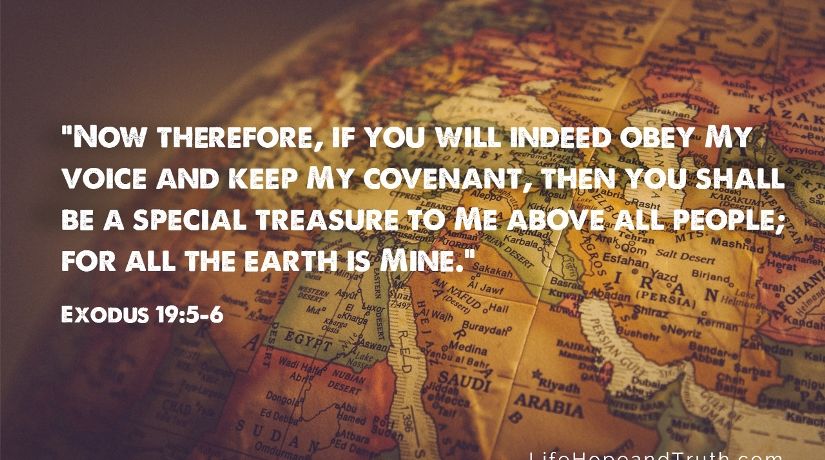.
What Is the Old Covenant?
 “The Bible speaks of an Old Covenant and a New Covenant. What was the Old Covenant? Were God’s laws abolished along with the Old Covenant?
“The Bible speaks of an Old Covenant and a New Covenant. What was the Old Covenant? Were God’s laws abolished along with the Old Covenant?
Covenants are common in our modern day, as they were in biblical times. A covenant is a formal, binding contract or agreement between two or more parties, in which each party agrees to abide by specific terms spelled out by the covenant.
So what is the Old Covenant?
Background of the Old Covenant
The roots of the Old Covenant actually trace back to Abraham, the forefather of Israel. God initiated a covenant with Abraham in which He promised to make a special nation of his descendants. It is these descendants who later entered into a covenant with God at Mount Sinai.
Notice the following scriptures in which God spells out specific promises to Abraham and his descendants. These promises include:
- Becoming a populous nation and a company of nations (Genesis 12:2; 15:5; 17:2-7; 35:11).
- Specific real estate—the Promised Land (Genesis 13:15; 15:18-21; 17:7-8).
- National greatness (Genesis 22:17; 27:28-29; 28:13-14).
These covenanted promises passed from Abraham to his son Isaac (Genesis 17:19), to Isaac’s son Jacob (whom God renamed “Israel”—see Genesis 35:10-12; 28:3-4, 13-14), to Israel’s 12 sons (Genesis 49), and to their offspring (who became the 12 tribes of Israel).
After Abraham’s death, the family eventually ended up in Egypt, and they grew prolifically. Exodus 1 records that while in Egypt, they became entrapped in a life of bondage. “So God heard their groaning, and God remembered His covenant with Abraham, with Isaac, and with Jacob” (Exodus 2:24, emphasis added throughout).
The next 10 chapters record God’s intervention to extricate Israel from Egypt, through the famous 10 plagues and the appointment of Moses as God’s spokesman.
Then, 430 years after confirming the covenant with Abraham, God brought his descendants out of slavery, free at last to begin living as an independent nation (see Exodus 12:40-41).
Israel’s formal introduction to the covenant”
Continued at: https://lifehopeandtruth.com/bible/covenants/old-covenant/
________
The New Covenant: What Is New About It?

“What was the problem with the Old Covenant, and what really changed with the New Covenant? What does the Bible say is new about the New Covenant?
Throughout history, God has made various covenants, or agreements, with human beings. These covenants lay out the terms of the relationship God wants to have with humanity. Two of the key covenants recorded in the Bible are:
The covenant God made with ancient Israel at Mount Sinai, also referred to as the “Old Covenant.”
The “New Covenant,” which was inaugurated by Jesus Christ, and which is the covenant that is in force for spiritual Israel, the Church.
Scripture states that the New Covenant is making the Old Covenant obsolete (Hebrews 8:13). But what does that mean? Did God create an entirely different set of terms for this new agreement? Just what is “new” about the New Covenant?
This article highlights four key changes from the Old Covenant to the New Covenant. Although these four items do not encompass every difference, they illustrate the fundamental distinction between the two agreements.
A change of the sacrificial law
The Bible states that sinners earn the death penalty (Romans 6:23). Forgiveness of those sins requires blood to be shed to satisfy that penalty (Hebrews 9:22). Under the Old Covenant, the Israelites sacrificed animals as sin offerings, shedding the blood of those creatures as God commanded.
However, animal sacrifices were insufficient as substitutes for human beings. The sacrifices did not truly cleanse the Israelites from their wrongdoing, “for it is not possible that the blood of bulls and goats could take away sins” (Hebrews 10:4).
Since animal sacrifices could not blot out sins, why did God require them under the Old Covenant? Because those sacrifices reminded Israel of their sins and pictured the time when removal of the death penalty would truly become possible! God never intended for those sacrifices to be in force permanently! He had a plan in place “from the foundation of the world” to have Jesus Christ make the ultimate sacrifice (Revelation 13:8).
Christ’s sacrifice of Himself made it possible to take “away the sin of the world” (John 1:29). Because He is God, and human beings were created through Him (Colossians 1:16), His life is worth immeasurably more than all other human lives throughout history. Thus, His sacrifice was more than sufficient as total payment for the death penalty we have earned because of sin.
When Christ instituted the New Covenant with His shed blood (Luke 22:20), He made it possible for us to be truly cleansed from sin (Hebrews 9:13-14; 1 John 1:7). The result was that animal sacrifices were no longer required as symbols, because Christ was the ultimate fulfillment of that symbolism. We accept Christ’s sacrifice at baptism. Although we must still repent each time we sin in the future, Christ’s sacrifice is applied upon our repentance—no further sacrifices for our sins are needed (Hebrews 9:24-28; 10:12).
A change of the priesthood
Under the Old Covenant, priests came from the family of Aaron in the tribe of Levi. The high priest was required to offer a sacrifice for the Israelites’ sins each year on the Day of Atonement (Leviticus 16:29-34). He alone was allowed to enter the Most Holy Place (the innermost room) in the tabernacle and to approach the mercy seat—which represented the throne of God.
The Israelites all deserved the death penalty for their sins, and so the high priest’s responsibility was to make intercession for them. Since he was also “subject to weakness,” he understood how easy it was to sin, and he could show compassion for the people (Hebrews 5:1-4).
However, as we saw, the shed blood came from animal sacrifices under this physical system. Thus the priests under the Old Covenant were not able to truly make people right with God, and a change was necessary (Hebrews 7:11-12).
That change came with Jesus Christ’s sacrifice for all humanity, which fulfilled the symbolism of the yearly sin offering on the Day of Atonement. But Christ also filled the role of the high priest by offering Himself. He continues to serve as our High Priest, interceding on our behalf (Hebrews 7:23-28).
Under the New Covenant, Christ does not serve in a physical tabernacle (Hebrews 9:11). Instead, He performs His duties as High Priest in “the true tabernacle” (Hebrews 8:1-2). Today the Church is “the household of God” and “a holy temple” (Ephesians 2:19-22).
Members of the Church are able to draw near to the true mercy seat—the throne of God—as they develop a close and meaningful relationship with the Father. This is made possible because of Christ’s sacrifice and His continuing role as our High Priest (Hebrews 10:19-22).
Due to the change from the Levitical priesthood and the physical tabernacle, the rituals associated with the tabernacle and temple under the Old Covenant are no longer required—including various types of food and drink offerings, as well as ceremonial washings. These physical rituals were only “imposed until the time of reformation” (Hebrews 9:8-10)—which Jesus Christ ushered in with the New Covenant.
Under the New Covenant, God’s people now have a High Priest in Jesus Christ who intercedes for them continually. Since Christ lived as a human being, He understands our weaknesses, can help us when we are tempted, and can show us compassion when we sin. We can therefore be confident in seeking forgiveness when we repent (Hebrews 2:17-18; 4:14-16).
A change of the heart
God gave Israel His eternal laws that define sin—with the 10 Commandments serving as the core of Israel’s responsibility under the Old Covenant (Exodus 34:27-28; Deuteronomy 4:13). However, there was one key problem with this arrangement: Although God’s law was, and is, perfect (Psalm 19:7), the people were not.
God knew in advance that the Israelites were missing something very important. They did not have the necessary heart to be truly obedient to Him (Deuteronomy 5:23-29). The Israelites agreed to obey God because of external motivation. They were afraid of punishment from God (Exodus 20:18-21), but that type of external motivation does not guarantee right behavior! Unless a person is internally convicted to do what is right, it can become far too easy to choose to do what is wrong instead.
Ancient Israel sadly fell into this trap and repeatedly disobeyed God throughout history, despite the fact that they suffered punishment as a result. Time and time again, the Israelites broke the covenant they made with God, illustrating a key flaw in the covenant. The flaw was not with the laws they agreed to obey, but rather with the people themselves (Hebrews 8:7-8)!
The Israelites did not have a heart to truly know God because the time was not yet right for God to give them that heart (Deuteronomy 29:4). But even without a right heart, it was still possible for the Israelites to respond to the correction God gave them when they made wrong choices. Unfortunately, they failed to adjust their behavior in the long run. However, their example provides a powerful lesson to us of how easy it is to sin (1 Corinthians 10:11-12).
Under the New Covenant, God’s people have the opportunity to receive a heart to obey Him. In the Old Testament, God announced that the time would come when His people would have His laws internalized and written on their hearts—when they would truly be able to know Him (Jeremiah 31:31-34).
When God’s Spirit was made widely available on the Day of Pentecost, that goal became possible. Through the power of the Holy Spirit, Christians become able to think like God (1 Corinthians 2:11, 16). God’s mind—reflected in His law of love—can now be internalized within His people.
A change of promises
Under the Old Covenant, Israel agreed to obey God; and in return, God agreed to treat Israel as “a special treasure” (Exodus 19:5-6). He promised Israel specific blessings, including rain at the appropriate time; victory in battle; freedom from sickness; a fear of Israel among other nations; and such tremendous prosperity that Israel would lend to other nations, not borrow (Leviticus 26:3-13; Deuteronomy 7:12-15; 28:1-14).
These promises were all incredible. But they were also all limited to this physical existence! There was no opportunity under the Old Covenant for the nation of Israel to receive access to the gift of eternal life. Thus, the Israelites could only enjoy the blessings of the Old Covenant during their life span on this earth.
Why was eternal life not offered under the Old Covenant? Because Jesus Christ had not yet come to this earth as humanity’s Savior, and “there is no other name under heaven given among men by which we must be saved” (Acts 4:12). Christ’s sacrifice provided a way for humans who had not lived perfectly (all of us!) to avoid the death penalty. Forgiveness was a key requirement so that human beings could “receive the promise of the eternal inheritance” (Hebrews 9:15)—eternal life (Titus 3:7).
Another necessary missing component is the Holy Spirit. Jesus Christ called it “the Helper” (John 16:7), a “Promise” from God that He gave on the Day of Pentecost (Acts 1:4-5; 2:1-4).
As covered earlier, the Holy Spirit enables God’s laws to be written on our hearts. But beyond that, the Holy Spirit makes it possible for us to be “heirs of God,” so that we can “be glorified together” with Christ (Romans 8:16-17). God’s Spirit serves as a guarantee, or down payment, on our promised inheritance of eternal life in God’s family (Ephesians 1:13-14).
The Holy Spirit was made available to a select few of God’s servants who lived prior to Christ’s inauguration of the New Covenant (1 Peter 1:10-11). However, the vast majority of the Israelites did not have access to that Spirit, and thus did not have access to eternal life. But God intended from the beginning for all human beings to have that opportunity (Titus 1:2)—His purpose is to bring “many sons to glory” (Hebrews 2:10), expanding His family.
Access to salvation under the New Covenant makes this “a better covenant” than the covenant at Mount Sinai, because the New Covenant “was established on better promises” (Hebrews 8:6). Ultimately, all human beings throughout history will have an opportunity for eternal life as part of the New Covenant. Those who become part of God’s family will dwell with Him forever, and there will be no more death (Revelation 21:1-4).
The New Covenant amplifies the terms of the Old Covenant
This article has not covered every difference between the Old and New Covenants. However, the changes we have examined illustrate a consistent trend: Contrary to the belief of many, the New Covenant does not abolish all the terms of the Old Covenant!
Both covenants include provisions for a sacrifice for sin, a priesthood serving in a tabernacle, obedience to God’s laws, and promised blessings from God. However, in each case, the changes in the New Covenant amplify the terms of the Old Covenant!
Under the Old Covenant, God presented the Israelites with two options and told them to “choose life” (Deuteronomy 30:19-20). God offers that same choice today to those whom He calls into the New Covenant. What makes the New Covenant “new” is that it is a far better agreement than the one entered into at Mount Sinai.
Ultimately all humanity will have the opportunity to be part of the New Covenant. But if God is calling you to be part of that covenant now by helping you to understand His truth, you have a decision to make. Will you choose life—eternal life? The choice is up to you.” From: https://lifehopeandtruth.com/bible/covenants/the-new-covenant/?
For further study on this topic, read the article “Biblical Covenants.”
________
WHO report says eating processed meat is carcinogenic: Understanding the findings
“The World Health Organization (WHO)’s International Agency for Research on Cancer (IARC) announced that consumption of processed meat is “carcinogenic to humans (Group I ),” and that consumption of red meat is “probably carcinogenic to humans (Group 2A).” The report differentiates the two meats as follows:
- Processed meat – meat that has been transformed through salting, curing, fermentation, smoking, or other processes to enhance flavor or improve preservation
- Red meat – unprocessed mammalian muscle meat such as beef, veal, pork, lamb, mutton, horse and goat meat
Consumption of processed meat was classified as carcinogenic and red meat as probably carcinogenic after the IARC Working Group – comprised of 22 scientists from ten countries – evaluated over 800 studies. Conclusions were primarily based on the evidence for colorectal cancer. Data also showed positive associations between processed meat consumption and stomach cancer, and between red meat consumption and pancreatic and prostate cancer.
- Meat processing such as curing (e.g. by adding nitrates or nitrites) or smoking can lead to the formation of potentially cancer-causing (carcinogenic) chemicals such as N-nitroso-compounds (NOC) and polycyclic aromatic hydrocarbons (PAH).
- Meat also contains heme iron, which can facilitate production of carcinogenic NOCs.
- Cooking – especially high-temperature cooking including cooking meats over a flame (e.g., pan-frying, grilling, barbecuing) – can also produce carcinogenic chemicals, including heterocyclic aromatic amines (HAA) and PAHs.
To help further explain the report findings we spoke with Kana Wu, a member of the IARC Monograph Working Group for this report and a Senior Research Scientist in the Department of Nutrition at Harvard T.H. Chan School of Public Health.
The IARC Working Group said red meat is “probably” carcinogenic, but several studies showed no clear association. Can you explain why it’s probably carcinogenic?
In large population studies, but not all of them, greater red meat consumption has been associated with higher risk of colorectal cancer. Although these studies were not entirely consistent, results of laboratory studies led the IARC working group to conclude that red meat is probably carcinogenic.
Some reports in the media, particularly those from the meat industry, promote red meat consumption as part of a healthy and balanced diet. Is this true?
While it is true that red meat has nutritional value – it is rich in protein, minerals and vitamins (e.g., vitamin B12) – many studies have also shown that high consumption of red meat can increase the risk of colorectal cancer, heart disease, diabetes, and other chronic diseases, and may lead to higher risk of dying of those diseases (when compared to other good sources of protein, such as poultry, fish or legumes). Thus, much evidence suggests that an optimally healthy diet would be low in red meat.
The IARC/WHO classified processed meat as a Group 1 carcinogen, the same category as tobacco smoking and asbestos. Some media reports have indicated that eating bacon or hot dogs is as bad as smoking. Is this true?
It has been known for a while that high consumption of red or processed meat can adversely affect health, including raising risk of colorectal cancers and some other cancers.” Continued at: https://www.hsph.harvard.edu/nutritionsource/2015/11/03/report-says-eating-processed-meat-is-carcinogenic-understanding-the-findings/
________
 “As the U.S. holiday of Thanksgiving comes around again, we are reminded of America’s founding and how far the nation has drifted from the devotion to God on which it was founded.
“As the U.S. holiday of Thanksgiving comes around again, we are reminded of America’s founding and how far the nation has drifted from the devotion to God on which it was founded.
 “Since the 1990s, there’s been something different about the food you eat everyday. It still looks the same, it tastes the same but it’s not the same nourishing food your grandparents ate. Lurking deep inside a fresh-grilled ear of corn or your favorite soy-based vegetarian dish could be a gut-destroying toxin. It’s called Bt toxin and what you don’t know about it could seriously affect your health.
“Since the 1990s, there’s been something different about the food you eat everyday. It still looks the same, it tastes the same but it’s not the same nourishing food your grandparents ate. Lurking deep inside a fresh-grilled ear of corn or your favorite soy-based vegetarian dish could be a gut-destroying toxin. It’s called Bt toxin and what you don’t know about it could seriously affect your health. Your immune system is designed to protect you against toxins and foreign invaders. Bt toxin is a foreign invader, which means the more you eat GMO foods, the worse you’ll feel. You may develop allergic symptoms such as sneezing, coughing, wheezing, watery eyes, asthma, and hives and be unable to figure out what’s causing them.
Your immune system is designed to protect you against toxins and foreign invaders. Bt toxin is a foreign invader, which means the more you eat GMO foods, the worse you’ll feel. You may develop allergic symptoms such as sneezing, coughing, wheezing, watery eyes, asthma, and hives and be unable to figure out what’s causing them. Even if you eat a primarily organic diet and “slip up” every once in the while by eating some corn chips laced with Bt toxin, the effects of the toxin can stay with you. Once inside your stomach, these Bt toxins take can over by destroying your natural gut flora and forcing your digestive system into
Even if you eat a primarily organic diet and “slip up” every once in the while by eating some corn chips laced with Bt toxin, the effects of the toxin can stay with you. Once inside your stomach, these Bt toxins take can over by destroying your natural gut flora and forcing your digestive system into 
 “What does the Bible mean when it talks about the children of God? What does this description mean for our purpose in life—now and forever?
“What does the Bible mean when it talks about the children of God? What does this description mean for our purpose in life—now and forever?





 “When you read the ingredient list of supermarket products, you’ll see many contain enriched flour. Enriched flour is flour that has had vitamins and minerals, usually, niacin, riboflavin, folic acid, thiamine, and iron, added to it. This sounds like a good thing. After all, you’re getting B-vitamins and iron when you eat foods made with enriched flour – but what sounds healthy isn’t always. Here’s why.
“When you read the ingredient list of supermarket products, you’ll see many contain enriched flour. Enriched flour is flour that has had vitamins and minerals, usually, niacin, riboflavin, folic acid, thiamine, and iron, added to it. This sounds like a good thing. After all, you’re getting B-vitamins and iron when you eat foods made with enriched flour – but what sounds healthy isn’t always. Here’s why.











